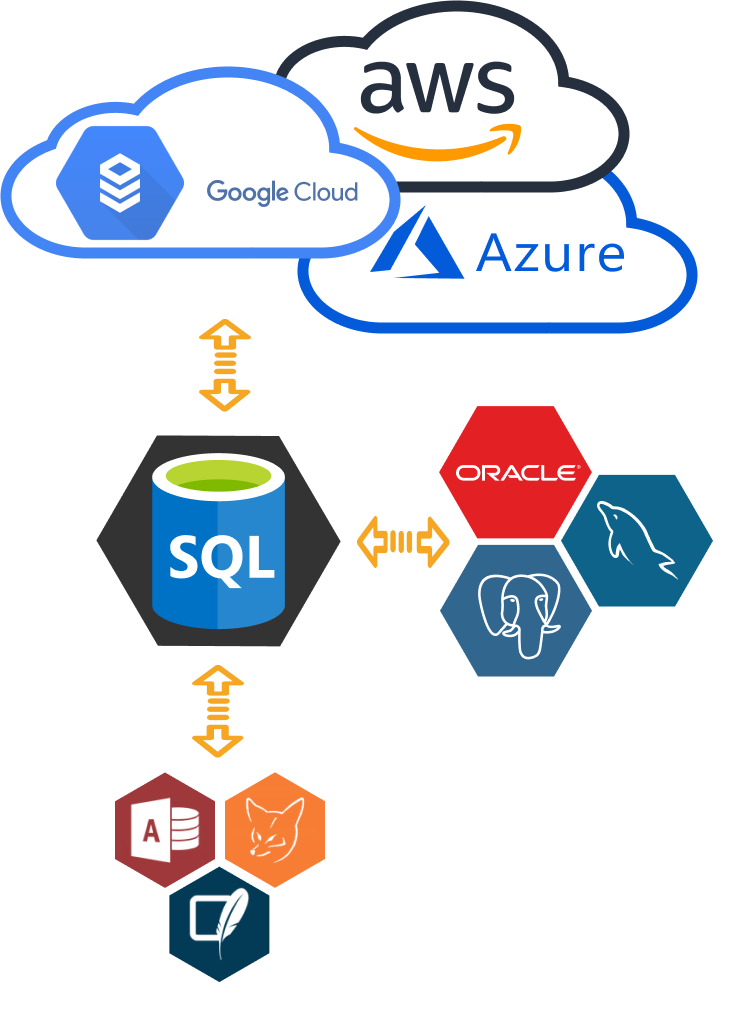SQL Server Migration & Synchronization
SQL Server is a relational database management system developed by Microsoft. It combines a very user-friendly interface with low-cost entry-level configurations. To get all benefits of the most advanced and the most enhanced sql server versions coming to market, organizations often decide to migrate to SQL Server (hosted in Azure SQL cloud or on-premise).
Three SQL Server migration paths to go.
- It would be an obvious choice to migrate overgrown access databases or obsolete foxpro data to on-premises sql server as they are all produced by the same vendor.
- However, for large data storage volumes with many clients, it would be reasonable to consider migrating a database to cloud-based solutions like:
-
Keeping the same database type as the on-premises database when moving to the cloud lets reduce the maintenance cost of a self-managed database server.
If increasing SQL Server licensing costs becomes an issue, migration to free PostgreSQL or Firebird databases might be another way to go.

Synchronize SQL Server database.
Once you shifted your source database to the target database, you might want to synchronize your databases. This can be achieved by checking one database for updates and then applying them to another database. The source you are migrating continues to change after the initial migration occurs. It drifts from the target database in terms of data and schema.
SQL Server DBSync tools serve to perform Update, Insert, and Drop synchronization to keep your source and target databases in sync.
Sync SQL Server databases with Azure cloud or configure one of the DBSync products listed on this page to synchronize SQL Server databases with other clouds or many on-premises database types.
Also, DBSync software is enhanced by bidirectional replication between SQL Server and other databases. In this scenario, two different databases simultaneously replicate changes from each other.
Homogenous vs. heterogeneous database migrations.
Depending on the need, you can shift your database either to the same type of database or to a new kind of database.
Why move to the same type of database?
- You're upgrading an on-premises SQL Server to a later version of on-premises SQL Server.
- Move your data from on-premises SQL Server to Azure SQL cloud.
- Convert databases in the opposite direction from Azure SQL to on-premises SQL Server is also possible.
- Synchronize on-premises SQL Server databases.
- Sync on-premises SQL Server to Azure Database.
Note: You can choose any software listed below to perform homogenous database conversion or sync operations. As a bonus, you get one more database which you can select as a source or target.
Why shift to the new kind of database?
For businesses that require switching to another type of database, we offer DBConvert and DBSync heterogeneous cross-database migration software solutions.
To migrate and sync your data between SQL Server and the most popular directions like MySQL, Oracle, Postgres, choose a required migration or synchronization tool from the list at the bottom of the page.
Note: All DBConvert software listed in the sidebar performs database migration or sync in both directions:
- SQL Server to Any Database;
- Any database to SQL Server;
Why use software from DBConvert for SQL Server migration and Synchronization?
Although you can use the SQL Server Migration Assistant to automate database migration from multiple DBMSs to SQL Server, they have some drawbacks. DBConvert products address these shortcomings.
- SSMA migration tools can migrate data in one direction only when the target database is SQL Server. In DBConvert, you can easily set SQL Server as a source and another database as a target when migrating or syncing databases.
- At the moment of writing, the SQL Server Migration Assistant has a limited number of source databases to choose from. Refer to the table below to see the list of supported databases.
| SQL Server Migration Assistant | DBConvert Applications |
|---|---|
| Access | Access |
| DB2 | DB2 |
| MySQL | MySQL |
| Oracle | Oracle |
| - | PostgreSQL |
| - | FoxPro |
| - | SQlite |
| - | Firebird / Interbase |
| - | Excel |
Related Links
The most popular migration directions
Supported SQL Server versions
- SQL Server (Express) 2000/2005/2008/2008 R2/2012/2014/2016
- SQL Server 2017, 2019 on Windows and Linux
- Azure SQL databases, Azure SQL Data Warehouse
- Google Cloud SQL for SQL Server
- AWS RDS for SQL Server